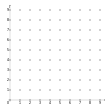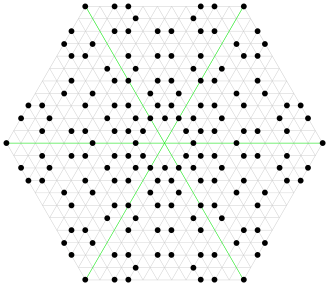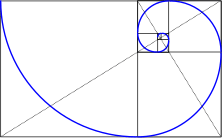Quadratic integer
In number theory, quadratic integers are a generalization of the integers to quadratic fields. Quadratic integers are algebraic integers of degree two, that is, solutions of equations of the form
- x2 + bx + c = 0
with b and c integers. When algebraic integers are considered, the usual integers are often called rational integers.
Common examples of quadratic integers are the square roots of integers, such as √2, and the complex number i = √–1, which generates the Gaussian integers. Another common example is the non-real cubic root of unity −1 + √–3/2, which generates the Eisenstein integers.
Quadratic integers occur in the solutions of many Diophantine equations, such as Pell's equations, and other questions related to integral quadratic forms. The study of rings of quadratic integers is basic for many questions of algebraic number theory.
History
Medieval Indian mathematicians had already discovered a multiplication of quadratic integers of the same D, which allowed them to solve some cases of Pell's equation.
The characterization given in § Explicit representation of the quadratic integers was first given by Richard Dedekind in 1871.[1][2]
Definition
A quadratic integer is an algebraic integer of degree two. More explicitly, it is a complex number , which solves an equation of the form x2 + bx + c = 0, with b and c integers. Each quadratic integer that is not an integer is not rational—namely, it's a real irrational number if b2 – 4c > 0 and non-real if b2 – 4c < 0—and lies in a uniquely determined quadratic field , the extension of generated by the square-root of the unique square-free integer D that satisfies b2 – 4c = De2 for some integer e. If D is positive, the quadratic integer is real. If D < 0, it is imaginary (that is complex and nonreal).
The quadratic integers (including the ordinary integers), which belong to a quadratic field , form an integral domain called the ring of integers of
Although the quadratic integers belonging to a given quadratic field form a ring, the set of all quadratic integers is not a ring because it is not closed under addition or multiplication. For example, and are quadratic integers, but and are not, as their minimal polynomials have degree four.
Explicit representation
Here and in the following, the quadratic integers that are considered belong to a quadratic field where D is a square-free integer. This does not restrict the generality, as the equality √a2D = a√D (for any positive integer a) implies
An element x of is a quadratic integer if and only if there are two integers a and b such that either
or, if D – 1 is a multiple of 4
- with a and b both odd
In other words, every quadratic integer may be written a + ωb , where a and b are integers, and where ω is defined by:
(as D has been supposed square-free the case is impossible, since it would imply that D would be divisible by the square 4).[3]
Norm and conjugation
A quadratic integer in may be written
- a + b√D,
where a and b are either both integers, or, only if D ≡ 1 (mod 4), both halves of odd integers. The norm of such a quadratic integer is
- N(a + b√D) = a2 – Db2.
The norm of a quadratic integer is always an integer. If D < 0, the norm of a quadratic integer is the square of its absolute value as a complex number (this is false if D > 0). The norm is a completely multiplicative function, which means that the norm of a product of quadratic integers is always the product of their norms.
Every quadratic integer a + b√D has a conjugate
A quadratic integer has the same norm as its conjugate, and this norm is the product of the quadratic integer and its conjugate. The conjugate of a sum or a product of quadratic integers is the sum or the product (respectively) of the conjugates. This means that the conjugation is an automorphism of the ring of the integers of —see § Quadratic integer rings, below.
Quadratic integer rings
Every square-free integer (different from 0 and 1) D defines a quadratic integer ring, which is the integral domain consisting of the algebraic integers contained in It is the set Z[ω] = {a + ωb : a, b ∈ Z}, where if D = 4k +1, and ω = √D otherwise. It is often denoted , because it is the ring of integers of Q(√D), which is the integral closure of Z in The ring Z[ω] consists of all roots of all equations x2 + Bx + C = 0 whose discriminant B2 − 4C is the product of D by the square of an integer. In particular √D belongs to Z[ω], being a root of the equation x2 − D = 0, which has 4D as its discriminant.
The square root of any integer is a quadratic integer, as every integer can be written n = m2D, where D is a square-free integer, and its square root is a root of x2 − m2D = 0.
The fundamental theorem of arithmetic is not true in many rings of quadratic integers. However, there is a unique factorization for ideals, which is expressed by the fact that every ring of algebraic integers is a Dedekind domain. Being the simplest examples of algebraic integers, quadratic integers are commonly the starting examples of most studies of algebraic number theory.[4]
The quadratic integer rings divide in two classes depending on the sign of D. If D > 0, all elements of are real, and the ring is a real quadratic integer ring. If D < 0, the only real elements of are the ordinary integers, and the ring is a complex quadratic integer ring.
For real quadratic integer rings, the class number, which measures the failure of unique factorization, is given in OEIS A003649; for the imaginary case, they are given in OEIS A000924.
Units
A quadratic integer is a unit in the ring of the integers of if and only if its norm is 1 or –1. In the first case its multiplicative inverse is its conjugate. It is the negation of its conjugate in the second case.
If D < 0, the ring of the integers of has at most six units. In the case of the Gaussian integers (D = –1), the four units are 1, –1, √–1, –√–1. In the case of the Eisenstein integers (D = –3), the six units are ±1, ±1 ± √–3/2. For all other negative D, there are only two units, which are 1 and –1.
If D > 0, the ring of the integers of has infinitely many units that are equal to ±ui, where i is an arbitrary integer, and u is a particular unit called a fundamental unit. Given a fundamental unit u, there are three other fundamental units, its conjugate and also and Commonly, one calls the fundamental unit, the unique one which has an absolute value greater than 1 (as a real number). It is the unique fundamental unit that may be written as a + b√D, with a and b positive (integers or halves of integers).
The fundamental units for the 10 smallest positive square-free D are 1 + √2, 2 + √3, 1 + √5/2 (the golden ratio), 5 + 2√6, 8 + 3√7, 3 + √10, 10 + 3√11, 3 + √13/2, 15 + 4√14, 4 + √15. For larger D, the coefficients of the fundamental unit may be very large. For example, for D = 19, 31, 43, the fundamental units are respectively 170 + 39 √19, 1520 + 273 √31 and 3482 + 531 √43.
Examples of complex quadratic integer rings


For D < 0, ω is a complex (imaginary or otherwise non-real) number. Therefore, it is natural to treat a quadratic integer ring as a set of algebraic complex numbers.
- A classic example is , the Gaussian integers, which was introduced by Carl Gauss around 1800 to state his biquadratic reciprocity law.[5]
- The elements in are called Eisenstein integers.
Both rings mentioned above are rings of integers of cyclotomic fields Q(ζ4) and Q(ζ3) correspondingly. In contrast, Z[√−3] is not even a Dedekind domain.
Both above examples are principal ideal rings and also Euclidean domains for the norm. This is not the case for
which is not even a unique factorization domain. This can be shown as follows.
In we have
The factors 3, and are irreducible, as they have all a norm of 9, and if they were not irreducible, they would have a factor of norm 3, which is impossible, the norm of an element different of ±1 being at least 4. Thus the factorization of 9 into irreducible factors is not unique.
The ideals and are not principal, as a simple computation shows that their product is the ideal generated by 3, and, if they were principal, this would imply that 3 would not be irreducible.
Examples of real quadratic integer rings

For D > 0, ω is a positive irrational real number, and the corresponding quadratic integer ring is a set of algebraic real numbers. The solutions of the Pell's equation X2 − D Y2 = 1, a Diophantine equation that has been widely studied, are the units of these rings, for D ≡ 2, 3 (mod 4).
- For D = 5, ω = 1+√5/2 is the golden ratio. This ring was studied by Peter Gustav Lejeune Dirichlet. Its units have the form ±ωn, where n is an arbitrary integer. This ring also arises from studying 5-fold rotational symmetry on Euclidean plane, for example, Penrose tilings.[6]
- Indian mathematician Brahmagupta treated the Pell's equation X2 − 61 Y2 = 1, corresponding to the ring is Z[√61]. Some results were presented to European community by Pierre Fermat in 1657.
Principal rings of quadratic integers
Unique factorization property is not always verified for rings of quadratic integers, as seen above for the case of Z[√−5]. However, as for every Dedekind domain, a ring of quadratic integers is a unique factorization domain if and only if it is a principal ideal domain. This occurs if and only if the class number of the corresponding quadratic field is one.
The imaginary rings of quadratic integers that are principal ideal rings have been completely determined. These are for
- D = −1, −2, −3, −7, −11, −19, −43, −67, −163.
This result was first conjectured by Gauss and proven by Kurt Heegner, although Heegner's proof was not believed until Harold Stark gave a later proof in 1967. (See Stark–Heegner theorem.) This is a special case of the famous class number problem.
There are many known positive integers D > 0, for which the ring of quadratic integers is a principal ideal ring. However, the complete list is not known; it is not even known if the number of these principal ideal rings is finite or not.
Euclidean rings of quadratic integers
When a ring of quadratic integers is a principal ideal domain, it is interesting to know whether it is a Euclidean domain. This problem has been completely solved as follows.
Equipped with the norm as a Euclidean function, is a Euclidean domain for negative D when
- D = −1, −2, −3, −7, −11,[7]
and, for positive D, when
There is no other ring of quadratic integers that is Euclidean with the norm as a Euclidean function.[8]
For negative D, a ring of quadratic integers is Euclidean if and only if the norm is a Euclidean function for it. It follows that, for
- D = −19, −43, −67, −163,
the four corresponding rings of quadratic integers are among the rare known examples of principal ideal domains that are not Euclidean domains.
On the other hand, the generalized Riemann hypothesis implies that a ring of real quadratic integers that is a principal ideal domain is also a Euclidean domain for some Euclidean function, which can indeed differ from the usual norm.[9] The values D = 14, 69 were the first for which the ring of quadratic integers was proven to be Euclidean, but not norm-Euclidean.[10][11]
Notes
- Dedekind 1871, Supplement X, p. 447
- Bourbaki 1994, p. 99
- "Why is quadratic integer ring defined in that way?". math.stackexchange.com. Retrieved 2016-12-31.
- M. Artin, Algebra (2nd ed) Ch 13
- Dummit, pg. 229
- de Bruijn, N. G. (1981), "Algebraic theory of Penrose's non-periodic tilings of the plane, I, II" (PDF), Indagationes Mathematicae, 43 (1): 39–66
- Dummit, pg. 272
- LeVeque, William J. (2002) [1956]. Topics in Number Theory, Volumes I and II. New York: Dover Publications. pp. II:57, 81. ISBN 978-0-486-42539-9. Zbl 1009.11001.
- P. Weinberger, On Euclidean rings of algebraic integers. In: Analytic Number Theory (St. Louis, 1972), Proc. Sympos. Pure Math. 24(1973), 321–332.
- M. Harper, is Euclidean. Can. J. Math. 56(2004), 55–70.
- David A. Clark, A quadratic field which is Euclidean but not norm-Euclidean, Manuscripta Mathematica, 83(1994), 327–330 Archived 2015-01-29 at the Wayback Machine
References
- Bourbaki, Nicolas (1994). Elements of the history of mathematics. Translated by Meldrum, John. Berlin: Springer-Verlag. ISBN 978-3-540-64767-6. MR 1290116.
- Dedekind, Richard (1871), Vorlesungen über Zahlentheorie von P.G. Lejeune Dirichlet (2 ed.), Vieweg. Retrieved 5. August 2009
- Dummit, D. S., and Foote, R. M., 2004. Abstract Algebra, 3rd ed.
- Artin, M, Algebra, 2nd ed., Ch 13.
Further reading
- J.S. Milne. Algebraic Number Theory, Version 3.01, September 28, 2008. online lecture notes